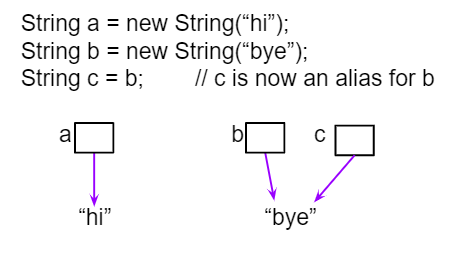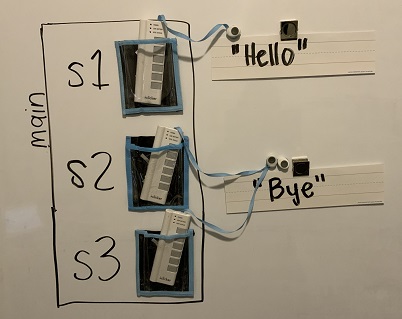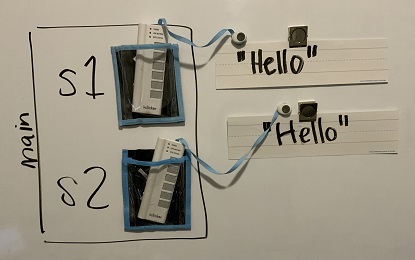Activity 9.2.1.
What will the code below print out? Try to guess before you run it! Then, add another Turtle friend2 and set it to juan. Does friend2 == juan? Does friend2 == friend? Print out the Boolean expressions for these.
int and reference types like Dog are compared with == in a physical model of Java memory.
== or != to test if two reference values, like Turtle and String objects, refer to the same object. In the figure below, we are creating two separate Turtle objects called juan and mia. They do not refer to same object or turtle. Then, we create a reference variable called friend that is set to mia. The turtle mia will have two ways (references or aliases) to name her – she’s both mia and friend, and these variables refer to the same object (same Turtle) in memory. If two reference variables refer to the same object like the turtle on the right in the image below, the test with == will return true which you can see in the code below.

Turtle objects have many instance variables like name, width, height, xPos, yPos, etc. When comparing two Turtle objects, we need a specially written equals method to compare all of these values. In the next sections, we will take a look at String objects and the difference between comparing them with == vs. the equals method.
s1.equals(s2) is true if s1 and s2 have all the same characters in the same order. With Strings and other objects, you almost always use equals instead of == to check their equality.
== or != is used to compare object variables, it returns true when the two variables refer to the same object. These variables are called object references and aliases for the same object. With strings this happens when one string variable is set to another.

== and equals work with String objects in memory.

new keyword to create a string, it will always create a new string object. So, even if we create two string objects with new that contain all the same characters in the same order, they will not refer to the same object.
new keyword, two different String objects will be created that each have the characters Hello in them. So s1 == s2 will be false since they don’t refer to the same object, but s1.equals(s2) is true since the two different objects contain the same characters in the same order.

equals but not with ==.Strings using string literals instead of new, like String s = "Hello". String literals behave a little differently because they are re-used if they already exist instead of creating a new object. But you should not see questions with string literals and == on the AP exam.
== and != with primitive types like int or to test if two strings (or objects) refer to the same object. Use equals, not == or !=, with strings to test if they are equal letter by letter, and with other objects to see if all of their relevant attributes are equal.
String s1 = new String("hi");
String s2 = new String("bye");
String s3 = new String("hi");
s2 = s1;
String s1 = new String("hi");
String s2 = new String("bye");
String s3 = new String("hi");
String s1 = new String("hi");
String s2 = new String("bye");
String s3 = new String("hi");
== or != with objects is to compare them to null to see if they really exist. Sometimes short-circuit evaluation is used to avoid an error if the object doesn’t exist. Remember that short-circuit evaluation is used with && in Java meaning that if the first part of the if condition is false, it doesn’t even have to check the second condition and it knows the whole && test is false.
NullPointerException (if you don’t see the exception because of the autograding, you can copy it into the pencil icon scratch area to run it without the grader). Since s is null, trying to access indexOf on s throws an NullPointerException. Comment out the first if statement and run the program again. The second if statement avoids the error with shortcircuit evaluation. Because s != null is false, the rest of the Boolean expression is not evaluated. Now, change s to set it to "apple" instead of null in the first line and run the code again to see that the if statements can print out that “apple contains an a”.